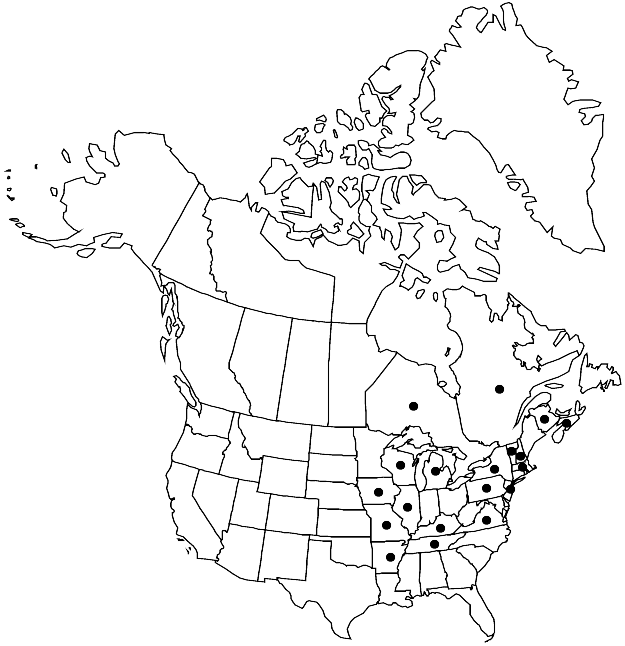Anomodon viticulosus
Muscol. Brit., 79. 1818.
Plants large, in thick mats, green. Stems 6–8+ cm, 1–1.8 mm thick when dry, somewhat branched, primary branches erect-ascending to arcuate; central strand cells not differentiated; pseudoparaphyllia absent; rhizoids few. Branch leaves erect when dry, secund, somewhat flexuose, spreading to reflexed when moist, oblong-ligulate, 2.2–4 mm; base broadly decurrent; margins plane, entire; apex obtuse, rounded, or sometimes acute, intact; costa strong, ending sharply before apex, occasionally obscured by laminal cells distally, rarely asymmetrically 2-fid at end, pellucid, lighter green, abaxial costa cells papillose, papillae thick, in rows; basal laminal cells hyaline, papilla 1, region barely extending beyond 1/4 length of leaf base; medial and distal cells hexagonal, 8–12 µm, papillae many, branched. Perichaetia borne distally from last branching points, leaves similar to vegetative leaves, costa ending closer to apex, laminal cells papillose. [Seta 1–2 cm. Capsule long-elliptic, urn (1.7–)2–3.1(–3.3) mm; stomata absent; annulus well differentiated; operculum obliquely rostrate, 0.7–1 mm; exostome teeth irregular, 0.3–0.5 mm, nearly smooth, faintly striolate, not trabeculate, papillae inconspicuous toward apex; endostome basal membrane 2–4 cells high, segments moderately developed. Spores very variable in diam. between capsules, in some (19–)20–23(–25) µm, in others 15–16 µm, densely papillose].
Phenology: Capsules mature early-mid fall.
Habitat: Mesic calcareous environments of montane deciduous forests, limestone rock or vertical walls, epiphytic
Elevation: moderate to high elevations
Distribution

N.B., N.S., Ont., Que., Ark., Ill., Iowa, Ky., Mass., Mich., Mo., N.H., N.J., N.Y., Pa., Tenn., Vt., Va., Wis., Mexico (Guerrero, Oaxaca), Europe, Asia.
Discussion
Anomodon viticulosus is the most robust species of the genus, forming thick mats on rocks and sometimes on tree trunks. The robust habit and thickness distinguish it from other species. When depauperate, A. viticulosus is distinguished from A. rugelii by its falcate-secund leaves, decurrent and tapering from the shoulders toward the apex; A. rugelii has leaves incurved when dry, lingulate beyond the shoulders, with characteristic auricles at the insertion. Unlike those of A. minor or A. rugelii, the apex of A. viticulosus is never rounded, nor are its terminal branches complanate. Anomodon viticulosus is sometimes mistaken for A. attenuatus; the latter has more prostrate stems and profuse branching in a pattern of successive orders of branching, with the terminal branches attenuate, complanate, crowded, and somewhat fasciculate. Anomodon viticulosus seldom fruits in North America (only one fruiting specimen seen) or Asia, most likely because of the lack of male gametophytes in these regions (Í. Granzow-de la Cerda 1989). Only one North American specimen was seen with sporophytes; the description is from European and Asian material.
Selected References
None.